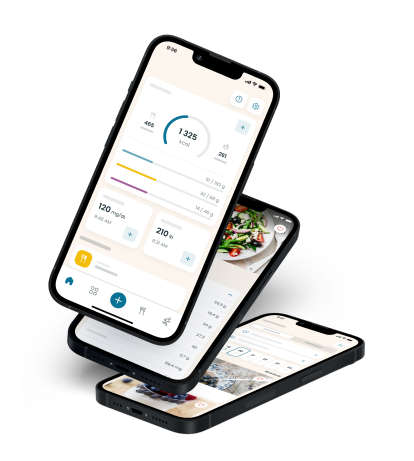Table of contents
What is gestational diabetes?
What is gestational diabetes?
Gestational diabetes is a temporary condition in which hormonal changes make it difficult for your body to use glucose, which then builds up in the blood. This generally occurs after 24 to 28 weeks of pregnancy.
Pregnancy diabetes specifically refers to diabetes that appears for the first time while you are pregnant. It's different from having type 1 diabetes or type 2 diabetes and becoming pregnant. Unlike those other forms of diabetes, gestational diabetes is a temporary condition.
There are two types of gestational diabetes: Class A1 and Class A2. Class A1 gestational diabetes can be controlled through diet. Class A2 pregnancy diabetes requires insulin or oral medications.
Even if the condition goes away after childbirth, it increases the risk that you may go on to develop type 2 diabetes in the future. This calls for regular testing.
More than a warning sign, gestational diabetes can cause unpleasant symptoms and increase pregnancy risks.
Causes
The exact cause of gestational diabetes is unknown, but it's believed to be related to hormonal changes during pregnancy. Hormones that increase the body's resistance to insulin are involved.
Glucose is the body's main energy source - your body breaks it down from food. Cells in muscles and other tissues of the body need it for energy. However, cells rely on insulin, the hormone regulating glucose levels, to absorb and use glucose effectively.
Getting pregnant increases the production of hormones that increase insulin resistance as well as the human placental lactogen released by the placenta to regulate metabolism. This occurs so that more glucose can be fed to the baby.
In some cases, this may increase the body's insulin resistance too much, leading to an effect similar to that at work in type 2 diabetes.
Risk factors for gestational diabetes include being overweight, physical inactivity, pre-diabetes, heart disease or high blood pressure, family history of diabetes, and polycystic ovary syndrome. Race can also increase risk - Black, Hispanic, Asian, and American Indian women face a higher risk.
Symptoms
Gestational diabetes does not typically cause any symptoms. When these occur, they may be mild and easy to ignore. They may include:
Symptoms of diabetic ketoacidosis include:
Frequent need to urinate
The kidneys may try to flush out excess glucose from the blood.
Excessive thirst
Frequent urination can remove large quantities of water, leading to dehydration.
Tiredness
Glucose accumulates in the blood rather than reaching muscle cells, and your body may feel more tired.
Blurry vision
High blood sugar levels may damage small capillaries in the eyes, causing blurriness that comes and goes.
Diagnosis
- One-step test - your fasting blood sugar levels will be tested, then you'll drink a glucose solution and get tested again one or two hours later. Fasting blood sugar levels >= 5.1 mmol/L, one-hour levels >= 10.0 mmol/L, or two-hour levels >= 8.4 mmol/L indicate gestational diabetes.
- Two-step test - for this test, you don't need to fast before drinking a glucose solution. You are tested after one hour. If the result is >= 7.2 mmol/L, you will be tested again on a different day, including fasting levels and blood sugar levels one, two, and three hours later.
Type 2 diabetes
Research indicates that the risk of developing type 2 diabetes after having gestational diabetes is around 19.72% ten years later. This risk increases considerably in time, almost tripling fifty years after childbirth.
Pregnancy diabetes is a major risk factor for type 2 diabetes, especially when it occurs in conjunction with being overweight or having a family history of diabetes.
Children whose mothers had gestational diabetes also have a higher risk of developing type 2 diabetes later on.
Recent studies indicate that if the mother has gestational hypertension alongside pregnancy diabetes, the father is also 80% more likely to develop type 2 diabetes.
Type 2 diabetes has many complications, including cardiovascular disease, nerve damage, eyesight loss, and kidney damage. However, it may be prevented and better managed through a healthy diet and lifestyle changes.
Children of mothers with gestational diabetes are at a higher risk of developing type 1 diabetes, according to this study.
- Respiratory distress syndrome and other breathing problems after-birth complications for the baby may include breathing problems. Respiratory Distress Syndrome is caused by a missing protein in the lungs.
- Jaundice and liver problems - the baby's skin and eyes may look yellow, indicating liver problems.
- Gestational diabetes in a future pregnancy - having pregnancy diabetes further increases the risk of developing the condition again during a new pregnancy.
Dangers for you and your baby
In addition to the future risk of diabetes for the whole family, gestational diabetes can pose risks during the pregnancy itself. These include:
- Hypertension - pregnancy diabetes may trigger high blood pressure while you are carrying your baby. If you already have high blood pressure, it may make it worse.
- Preeclampsia - this pregnancy complication involves hypertension and damage to other organs, such as the liver or kidneys. It may cause headaches, eyesight changes and trigger premature birth.
- Postpartum depression - this type of depression may occur during pregnancy or in the year following it.
- Caesarean section - while most women with pregnancy diabetes have a normal birth, they are more likely to need a c-section because of having a large baby (macrosomia).
- Birth injuries - shoulder dystocia and other birth injuries may occur due to the large size of the baby.
- Premature birth - most women with gestational diabetes have a normal pregnancy, but the condition increases the risk for complications leading to a premature birth before week 37.
- Low blood sugar - the baby may go on to develop hypoglycaemia.

Treatment
The treatment for gestational diabetes depends on your blood sugar levels. Close monitoring of these levels is important.
Eating healthy foods with a low glycaemic index and exercising regularly are usually enough to treat class A1 diabetes.
While there is no specific diet for gestational diabetes, a personalised meal plan that focuses on fruits, vegetables, healthy proteins and fats, and lean meat makes managing the condition easier.
If your blood sugar levels are very high, you may be prescribed insulin injections or oral medication to control blood sugar. This occurs if you have class A2 gestational diabetes. Up to 20% of women with pregnancy diabetes require insulin.
Prevention and tips
Although the exact cause of gestational diabetes is unknown, staying healthy and getting into good shape for your pregnancy may help lower the risk of gestational diabetes. There are also a few things you can do to lower your baby's risk of developing diabetes later on, such as:
- If you are overweight before becoming pregnant, lose weight by eating well and working out frequently.
- Exercise for at least 150 minutes every week before your pregnancy.
- Avoid drinking alcohol.
- Focus on eating vegetables, fruits, and whole grains while avoiding processed foods, sugary drinks, and other foods with a high glycaemic index.
- Adopt a personalised meal plan to optimise your nutrient, carb, and protein intake without giving up the joy of eating delicious foods.
- Breastfeed your baby to help reduce their risk of becoming overweight or developing diabetes later in life.
- If you have pre-diabetes, a family history of the condition, or had gestational diabetes during a previous pregnancy, discuss potential risk factors and screening with your doctor.
- During pregnancy, follow a baby-friendly workout. This can include yoga, pilates, swimming, jogging, as well as walking.
- After birth, teach your child healthy eating habits early on to help them reduce the risk of developing diabetes later in life.
Key Takeouts
Gestational diabetes may occur during pregnancy regardless of your diet or activity level.
Eating healthy and being physically active make it easier to manage.
In most cases, the condition doesn't require insulin or cause any complications. Of all types of diabetes, it's the easiest one to treat.
Ultimately, gestational diabetes is not a condition to stress about but an opportunity to eat healthier and make positive lifestyle choices.
Take a quiz and get your diabetes-friendly meal plan today!

Related articles

What is diabetes?
6 min read•2 January 2024

What is type 1 diabetes?
10 min read•8 January 2024

What is type 2 diabetes?
11 min read•15 January 2024

What is pre-diabetes?
6 min read•26 January 2024
Resources
Blog